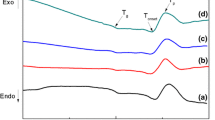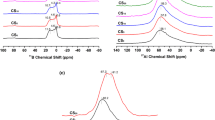Abstract
TiO2–BaO–SiO2 glass have been prepared by melt quenching method. The enhancement of glass coloration was observed as melting temperature increase. UV-Vis-NIR spectrophotometer reveals the change of glass transmittance. And the Ti2p3/2 and O1s XPS results shows that Ti ions exist in the Ti3+ and Ti4+ state in glass, Ti3+ proportion increased as melting temperature increasing, while more fourfold coordination [TiO4] tetrahedron appeared as the substitute of sixfold coordination [TiO6] octahedron. According to the analytic results, we demonstrate that the lack of free oxygen in glass at high melting temperature cause the decrease of the valence and coordination for Ti, and the strong absorption of Ti3+ and [TiO4] enhances the coloration of glass.



Similar content being viewed by others
REFERENCES
Ma, M., Ni, W., Wang, Y., Wang, Z., and Liu, F., The effect of TiO2 on phase separation and crystallization of glass–ceramics in CaO–MgO–Al2O3–SiO2–Na2O system, J. Non–Cryst. Solids, 2008, vol. 354, nos. 52–54, pp. 5395–5401.
Lacerda, S.R., Oliveira, J.M., Correia, R.N., and Fernandes, M.H.V., TiO2-induced phase separation and crystallization in SiO2–3CaO ⋅ P2O5–MgO glass, J. Non–Cryst. Solids, 1997, vol. 221, nos. 2–3, pp. 255–260.
Danewalia, S.S. and Singh, K., Intriguing role of TiO2 in glass ceramics: bioactive and magneto structural properties, J. Am. Ceram. Soc., 2018, vol. 101, no. 7, pp. 2819–2830.
Usui, Y., Okada, G., Kawaguchi, N., Masai, H., and Yanagida, T., Scintillation and optical properties of TiO2–ZnO–Al2O3–B2O3 glasses and glass–ceramics, Jpn. J. Appl. Phys., 2018, vol. 57, no. 4, p. 046203.
Masai, H., Tsuji, S., Fujiwara, T., Benino, Y., and Komatsu, T., Structure and non-linear optical properties of BaO–TiO2–SiO2 glass containing Ba2TiSi2O8 crystal, J. Non-Cryst. Solids, 2007, vol. 353, nos. 22–23, pp. 2258–2262.
Wisniewski, W., Döhler, F., Rüssel, C., Oriented nucleation and crystal growth of Ba-Fresnoite (Ba2TiSi2O8) in 2BaO ⋅ TiO2 ⋅ 2SiO2 glasses with additional SiO2, Cryst. Growth Des., 2018. https://doi.org/10.1021/acs.cgd.8b00312
Weiss, D.S.L., Torres, R. D., Buchner, S., Blunk, S., and Soares, P., Effect of Ti and Mg dopants on the mechanical properties, solubility, and bioactivity in vitro of a Sr-containing phosphate based glass, J. Non-Cryst. Solids, 2014, vol. 386, pp. 34–38.
Koudelka, L., Mošner, P., Zeyer, M., and Jäger, C., Lead borophosphate glasses doped with titanium dioxide, J. Non-Cryst. Solids, 2003, vols. 326–327, pp. 72–76.
Mao, Z., Wang, C., Zheng, X., Yu, J., and Xiong, L., Optical properties, thermal stability, and forming region of high refractive index La2O3–TiO2–Nb2O5 glasses, J. Am. Ceram. Soc., 2018, vol. 101, no. 4, pp. 1500–1507.
Van Vleck, J. H., Theory of the variations in paramagnetic anisotropy among different salts of the iron group, Phys. Rev., 1932, vol. 41, pp. 208–215.
Kumar, S., Cent. Glass Ceram. Res. Inst. Bull., 1959, vol. 6, p. 117.
Bamford, C. R., The application of ligand field theory to coloured glasses, Phys. Chem. Glasses, 1962, vol. 3, p. 189.
Bates, T., Modern Aspects of the Vitreous State, London: Butterworth, 1962.
Golovchak, R., Davis, M. J., Vullo, P., Astashkin, A., Nichols, L., Ingram, A., and Jain, H., The charge state of titanium ions in Pd-doped Ti:CMAS glass and glass-ceramics, J. Am. Ceram. Soc., 2017, vol. 100, no. 6, pp. 2568–2581.
Zhao, J., Xing, W., Li, Y., and Lu, K., Solvothermal synthesis and visible light absorption of anatase TiO2, Mater. Lett., 2015, vol. 145, pp. 332–335.
Moulder, J. F., Stickle, W. F., and Sobol, E., Handbook of X-ray Photoelectron Spectroscopy, Eden Prairie, MN: Perkin-Elmer, 1992.
Hashimoto, S., and Tanaka, A., Alteration of Ti 2p XPS spectrum for titanium oxide by low-energy Ar ion bombardment, Surf. Interface Anal., 2002, vol. 34, no. 1, pp. 262–265.
Gouttebaron, R., Cornelissen, D., Snyders, R., Dauchot, J. P., Wauelet, M., and Hecq, M., XPS study of TiOx thin films prepared by d.c. magnetron sputtering in Ar–O2 gas mixtures, Surf. Interface Anal., 2000, vol. 30, no. 1, pp. 527–530.
Schneider, M., Richter, W., Keding, R., and Rüssel, C., XPS investigations on coordination and valency of Ti in fresnoite glasses and glass ceramics, J. Non-Cryst. Solids, 1998, vol. 226, no. 3, pp. 273–280.
Bourhis, E. L., Glass Mechanics and Technology, Weinheim: Wiley-VCH, 2007.
Mann, J.B., Meek, T. L., and Allen, L. C., Configuration energies of the main group elements, J. Am. Chem. Soc., 2000, vol. 122, pp. 2780–2783.
Mann, J.B., Meek, T.L., Knight, E.T., Capitani, J.F., and Allen, L.C., Configuration energies of the d-block elements, J. Am. Chem. Soc., 2000, vol. 122, pp. 5132–5137.
Dalby, K.N., Nesbitt, H.W., Zakaznova–Herzog, V.P., and King, P.L., Resolution of bridging oxygen signals from O 1s spectra of silicate glasses using XPS: Implications for O and Si speciation, Geochim. Cosmochim. Acta, 2007, vol. 71, no. 17, pp. 4297–4313.
FUNDING
This work was supported by China Scholarship Council (no. 201506955051).
Author information
Authors and Affiliations
Corresponding author
Ethics declarations
The authors declare that they have no conflict of interest.
Rights and permissions
About this article
Cite this article
Peijing Tian, Peng, Z., Du, X. et al. The Effect of Melting Temperature on Coloration of TiO2–BaO–SiO2 Glass. Glass Phys Chem 45, 208–212 (2019). https://doi.org/10.1134/S1087659619030143
Received:
Revised:
Accepted:
Published:
Issue Date:
DOI: https://doi.org/10.1134/S1087659619030143




